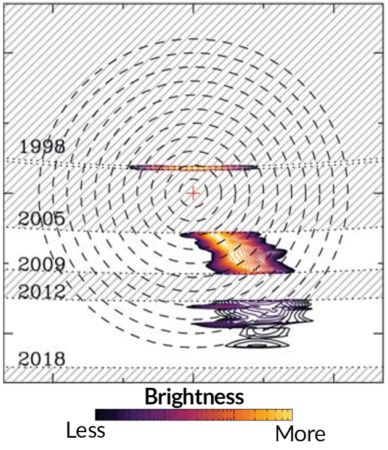6.09.2019
Astronomers get a novel look at the beams of radio waves emitted by a pulsating dead star

A quirk of Einstein’s general theory of relativity let astronomers map the beams of radio waves emitted by a type of neutron star called a pulsar. The pulsar orbits with another neutron star (illustrated).
Finally, scientists have their finger on the pulse.
Spinning dead stars, known as pulsars, blast powerful beams of radio waves into space. As a pulsar spins, its beams sweep past Earth, producing a pulsating signal similar to a lighthouse’s flashes. Astronomers now have mapped the structure of the beams of one pulsar, using observations made over decades. The technique relies on Albert Einstein’s theory of gravity, general relativity, and simultaneously reconfirms that the theory is correct, the scientists report in the Sept. 6 Science.
The result allowed researchers to “view the beam of a pulsar in a whole new way,” says astrophysicist Victoria Kaspi of McGill University in Montreal, who was not involved with the new study.
Pulsars are a type of neutron star, a dense remnant left behind when a star explodes. Powerful magnetic fields direct radio waves from a pulsar outward in beams. Typically, those beams pass by Earth at a fixed angle, and scientists can glimpse only a single slice through a beam as it rotates — like viewing a lighthouse beacon through a tiny slit.
But the newly mapped pulsar, known as PSR J1906+0746, was unusual: It was part of a duo, orbiting with another neutron star, about 20,000 light-years away from Earth (SN: 12/18/15). According to general relativity, if a pulsar spins at an angle misaligned with the pair’s orbit — which this one does — the pulsar will precess. That means that the axis on which the pulsar is spinning rotates, much like a wobbling top.
This precession allowed the scientists to catch different slices of the beam by observing the pulsar over time as it rotated. “From this we can learn many things about the structure of the emission,” says Gregory Desvignes of the Max Planck Institute for Radio Astronomy in Bonn, Germany.
Desvignes and colleagues monitored both the intensity of the beam and its polarization, the orientation of the wiggling of the electromagnetic waves that make it up. The polarization validated a 50-year-old theory about the geometry of pulsars and their magnetic fields.
And in a win for Einstein, the pulsar precessed at a rate of about 2.2 degrees per year — in agreement with the predictions of general relativity.
“It’s unbelievable,” Kaspi says. “You look at it and you go, ‘oh wow, isn’t that wonderful?’”
The results also revealed some unexpected features of the pulsar. Rather than the lighthouselike circular beams often assumed for pulsars, this pulsar’s beams were elongated. “It has this kind of funny shape,” says astrophysicist Maura McLaughlin of West Virginia University in Morgantown, who was not involved with the research. “This is cool because it shows that pulsars aren’t simple,” she says. And within the beam, the radio waves varied in brightness by up to a factor of several hundred from one point to another.
The new pulsar portrait could mean that scientists need to rethink some previous estimates of how common neutron stars are, and how often they partner up. If a neutron star has beams that never sweep past Earth, it won’t appear to pulse. So to account for the number that astronomers don’t see, they need accurate estimates of the size and shape of pulsars’ beams.
Future work could better pin down the neutron star census, and that may help scientists studying gravitational waves. The ripples in spacetime can be created when two orbiting neutron stars slam into one another (SN: 10/16/17). So better estimates of the population of neutron star pairs may help predict how often ripples from their collisions could rattle detectors in the future (SN: 5/6/19).
And this unusual pulsar will be fleeting, the researchers predict. Its angle is changing so much that in 2028, its beams will disappear entirely from Earth’s view.

